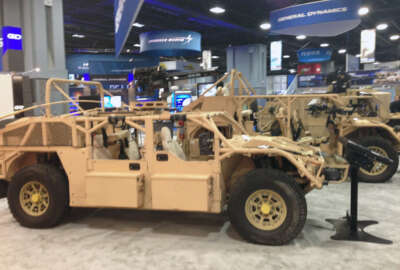
Soldiers’ gear going faster, better, cheaper, lighter, stronger…
The Army works continuously to improve on a basic piece of gear, namely the helmet on top of a soldier's head.
The Association of the U.S. Army convention, which just concluded in Washington, is a show that’s easy for guys to get into. Cannons; ground combat vehicles; giant turbo-charged engines; camouflage clothes; guns, ammo and knives of every size and description — what’s not to love?
Until you remind yourself that for the people who actually inhabit the vehicles, wear the uniforms, and use the weapons, combat in reality is an unpretty and potentially lethal phenomenon from which not everyone returns whole. Army soldiers are not weekend schlubs playing paintball.
The convention portion of the conference showed in part the Army’s relentless drive for incremental improvement in everything from multi-ton platforms to the helmets on soldiers’ heads. Not every vendor there makes helicopters, Humvees and grenade launchers.

So I stopped in the 3M booth. 3M — yes, the same company that makes Scotch tape and about a quadrillion other products — makes military helmets (and just about every other kind of helmet) via it’s Peltor subsidiary. I could sort of relate to helmets. I have two bicycle helmets and one motorcycle helmet. These are exacting items that can enhance an activity or detract from it if they don’t fit right. 3M’s Brian Parker said the Army is constantly pushing the limits of material physics in asking for ever-lighter and ever-stronger helmets, even as the market declines because of Army downsizing.
For some applications, standard Kevlar is giving way to an advanced form of polyethylene — ultra high molecular weight polyethylene, to be exact. It’s half the weight and can stop certain rifle shots — but costs twice as much.
I was impressed with the amount of engineering that does into an Army helmet. More than just a pot like Patton wears in old photos, modern helmets have all sorts of rails and mounting pads for paraphernalia night vision goggles.
3M also makes a military version of something you can actually buy retail. Under its Tactical Communications and Protection System program, or TCAPS, the Army is trying to better protect soldiers from hearing loss — the leading medical condition for soldiers and veterans. The Comtac 3 headphones clamp tightly about the ears, but let ordinary sounds come through. A soldier can use a tactical radio and hear the reply without pulling off conventional sound-blocking headphones. But an active electronic transient suppression system nullifies loud bangs, such as a mortar firing.
When the 3M rep put his hands right next to my ear, about to clap, I scrunched my eyes in anticipation of the noise. But the headphones reduced the loud clapping to a soft tap, while letting the ambient convention sound to keep coming through.
The Army is running a competition for the next generation of TCAPS hearing protection devices.
Helmets, headphones and the like may not carry the excitement of big platforms. Platforms can be so big and expensive they die under their own program complexity and weight. This happened to the Army’s Crusader cannon and Ground Combat Vehicle projects. But as long as the Army has soldiers with heads on their shoulders, it’ll need domes to protect them.
Copyright © 2025 Federal News Network. All rights reserved. This website is not intended for users located within the European Economic Area.
Tom Temin is host of the Federal Drive and has been providing insight on federal technology and management issues for more than 30 years.
Follow @tteminWFED





